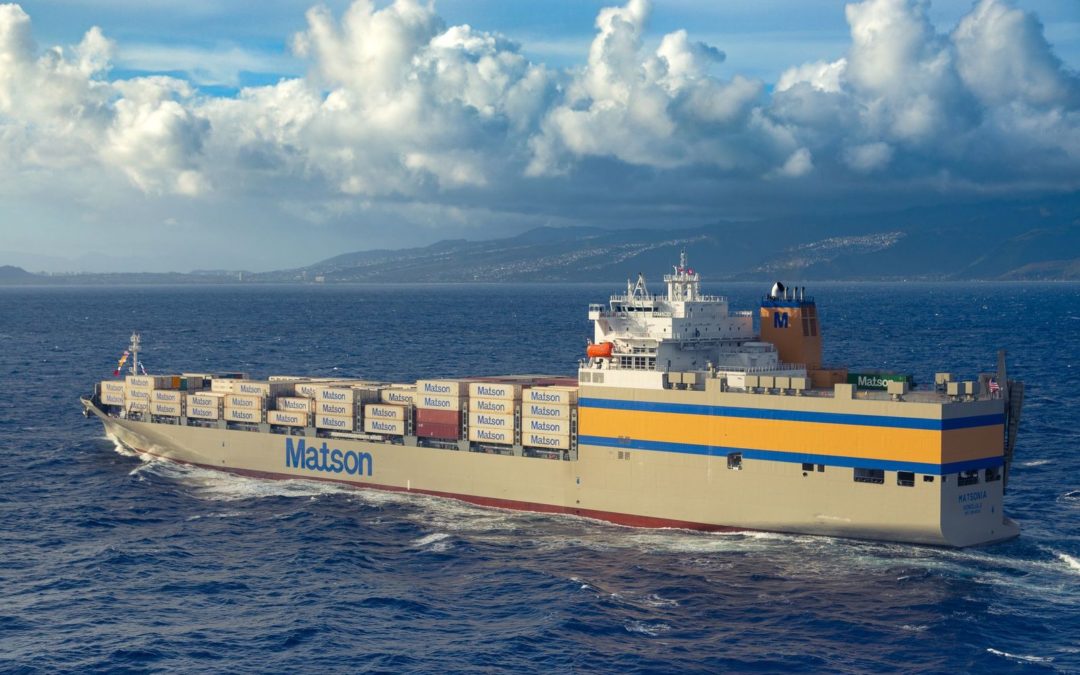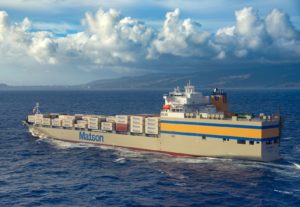Photo: Matson
By Stas Margaronis
The crisis faced by U.S. agricultural exporters unable to book sufficient space on foreign-flag ocean carriers will only be solved when the United States starts to build new ships, according to Dr. Salvatore R. Mercogliano, associate professor of history at Campbell University in North Carolina and adjunct professor at the U.S. Merchant Marine Academy.
In an interview, Mercogliano said that U.S. agricultural exporters and LNG exporters should become advocates for more U.S. flag shipping to provide guarantees that they can find U.S. vessels to carry their products.
Unfortunately, for those who sought deregulation so as to ship agricultural exports on lower cost foreign flag vessels during the 1980s, they are now facing a situation where “what you reap is what you sow.”
Sal Mercogliano
The United States Was World Shipbuilding Leader After World War II
Mercogliano noted that the impetus for the Jones Act or the Merchant Marine Act of 1920 was to avoid future disruptions in U.S. trade caused by cutbacks in British and German shipping during World War I: “The merchant fleets that we relied to haul our goods went away.”
This provided the basis for building up the U.S. coastal shipping fleet and would provide the basis for the U.S. Maritime Commission (now the Maritime Administration) to mass-produce Liberty ships and tankers during World War II.
The Maritime Commission financed and directed the mass-production Liberty ships and T-2 tankers using prefabricated methods that were deployed at U.S. shipyards including those run by Henry Kaiser and Daniel Ludwig. These methods that included sourcing components from U.S. suppliers and assembling them at the shipyards. This reduced the cost of building the shipyard, speeded up construction and created the maritime logistical conveyor belt that supplied war materiel to U.S. and Allied military operations in Europe and Asia during World War II.
After the war the United States gave up its leadership:
“The policy after the War was to rebuild foreign fleets and support foreign shipbuilding. We had a fleet that was 63% of the world fleet after World War II … (but) we rebuild fleets and win alliances through the Marshall Plan and the Ship Sales Act. We provide loans so foreign shipyards can be rebuilt. The big shipyards like Newport News and Bethlehem Steel the ones that build naval ships didn’t like the mass-production of Liberty ships because they wanted to build everything under one roof. They had the foundries and all those elements right there. Prefabrication takes components from everywhere and assembles them which is what modern shipyards are today … One of the reasons why our Navy finds itself in such poor shape today is that they rely on shipyards that build one or two ships a year rather than mass-producing ships so that you ask; ‘are you building ships or works of art?’ So, after World War II, the U.S. helps foreign shipyards build ships with this new technology of prefabrication which we developed before and during World Warr II and we go back to building ships in the old-fashioned way with these big shipyards … which is not as efficient…”
As a result of a lack of U.S. government support, a U.S. builder of tankers during World War II, Daniel Ludwig, relocated his company National Bulk Carriers to Japan in 1951 so that the company could construct large super tankers and bulk carriers in Japan.[1]
The result was:
” Daniel Ludwig’s deal to build the first of those super tankers … in Japan using American modular shipbuilding technology not only made him the father of modern Japanese shipbuilding but also of Korean and Chinese shipbuilding.”
Impact of Deregulation and Outsourcing
Mercogliano says the outsourcing of U.S. crewing to foreign nationals via registration of ships and companies in foreign countries also evaded U.S. taxes and the wages and working conditions accorded to mariners via U.S. union contracts and U.S. law:
“The creation of the open registries nations such as like Panama and Liberia and the Marshall Islands … This is our own doing. We are our own worst enemy in the United States. We created these foreign registries so carriers can get out of the laws of maritime countries such as the UK, Germany, United States and Japan and so they can hire cheap crews and I’m not under U.S. government taxation.”
In terms of deregulation, Mercogliano explained: “In the 1980s Reagan comes and … ends subsidies for building ships in U.S. shipyards and embraces deregulation of U.S. shipping under the Federal Maritime Commission through the Shipping Act of 1984… The effect of shifting our international trade onto foreign flag vessels kills building almost any commercial ships in U.S. yards The result is that in 2022 there are three deep draft ships being built at U.S. shipyards one in the Great Lakes and two for Pasha in Brownsville (Texas) ….”
Agricultural exporters “didn’t like using American ships because it was more expensive. Exporters loved deregulation. Today they find themselves sometimes unable to book space on foreign flag carriers. There is a huge opportunity to ship grain abroad and fill the gap created by the possible loss of Russian grain sales due to U.S. sanctions related to the conflict in the Ukraine. But U.S. exporters won’t realize that opportunity because the ocean carriers are focused on imports to the U.S. and not exports from the United States.”
The effect of deregulation has been to accelerate the concentration of container ocean shipping into the hands of a small group of ocean carriers who today “are emphasizing transporting high income imports into the United States instead of low-cost wheat or soybeans coming out of the United States. That’s the effect of shipping deregulation. I have a note from an agricultural exporter that he can’t book any refrigerated containers for export out of the Port of Seattle. It’s just one of many examples.”
Today the United States “have only one ocean carrier in the international trades and that is Matson (which) is the 26th largest carrier in the world.”
Previous requirements to provide cargo-preference on U.S. carriers were considered costly and archaic: “We conceded cargo-preference laws requiring the transport of U.S. cargoes on U.S. flag vessels.”
The alternative is to embrace cargo-preference or lose markets to foreign competitors: “If we mandate that some cargoes need to be carried on U.S. flag ships then we create a market for our ships. If we don’t have cargo preference, the other carriers will undercut us and drive us out of business so we need to protect our carriers.”
Mercogliano believes that attempting to push the Federal Maritime Commission to take action against foreign carrier practices is misguided since the power to act was undermined by deregulation.
The reality is:
“The foreign carriers are oligarchs. They control the freight rates. They’re the only business in town. We need cargo preference where part of our exports are hauled on U.S. ships. We need a tariff to support this. Second, we need to build American ships. They are going to be expensive to build and you’ll hear opposition from the Cato Institute …. so that’s true with one ship but if you build 20 ships you can bring down the cost.”
To achieve this end will require a major mobilization of U.S. resources to support U.S. shipbuilding and shipping. The current U.S. Maritime Administration (MARAD) loan guarantee program, the Title XI program, doesn’t work for anyone but a small group of established carriers. The investment needs to be seen as a long-term investment such as in roads and bridges: “We need to start investing in shipping. The problem is you don’t see a profit for a long time. The Title XI loan guarantee program has a debt-to-equity requirement that is crazy…”
China
While the United States ignores investing in its maritime industry, China continues to gain ground: “Between 2010 and 2018 China invested $132 billion in subsidies for ships. Over the same period, the U.S. Title XI program made $77 million not billion in loans. So, the U.S. is investing a fraction of what China is investing in shipping. What we are going to need is a start-up effort like the NASA Moon project.”
Finance is critical: “If we can invest in bitcoin a currency that really doesn’t exist, why can’t we invest in something like a ship which does exist? How do we make shipbuilding and shipping profitable? How do we attract investors and technology? Let’s not forget we are in a race to develop the next generation zero emission maritime fuel and propulsion. Whoever develops that new technology is going to make a fortune. It’s the revolution in maritime shipping and if we’re not involved in that someone else is going to profit. “
Today “the Chinese Shipbuilding Corporation builds more ships in one year than are in the entire U.S. Merchant Marine: 180 ships in 2021.”
China is ensuring that in the event of an emergency their trade is protected. China Ocean Shipping Company (COSCO) ensures a core fleet can meet China’s imports and exports move in case of a disruption. That is the plan of the Belt and Road initiative to ensure that if there is any disruption for any reason there is always a Plan B and Plan C.”
Building new ships will also help the U.S. Navy especially in an emergency such as the Russia/Ukraine crisis: “That ship is a national security asset for U.S. exporters and the U.S. Navy. Otherwise, the ship is rusting away in reserve as a tanker, RoRo or container ship. Instead, the merchant ship can be in an active maritime trade, can be training crews and utilizing U.S. shipyards for new and replacement ships and you can ping that ship for contingencies. You’ll still need some special ships in reserve.”
LNG Exporters Need U.S. Ships
U.S. LNG exporters can also benefit: “If Russian LNG exports are closed due to sanctions, then this is a huge opportunity for U.S. LNG producers. Right now, U.S. exporters have to get (foreign built) LNG carriers on the open market.”
This problem “could hurt our exporters if there is competition from an LNG exporter such as Qatar that has its own fleet of LNG carriers.”
According to a Reuters report, Qatar is not able to European demand for LNG if Russian supplies are cut off:
“Neither Qatar nor any other single country has the capacity to replace Russian gas supplies to Europe with liquefied natural gas (LNG) in the event of disruption due to a conflict between Russia and Ukraine, Qatar’s energy minister said on Tuesday…The United States and its European allies are set to announce fresh sanctions against Russia after President Vladimir Putin formally recognised the independence of the two regions in eastern Ukraine. The sanctions could affect the Russian flow of gas into Europe…“Russia (provides) I think 30-40% of the supply to Europe. There is no single country that can replace that kind of volume, there isn’t the capacity to do that from LNG,” minister Saad al-Kaabi told reporters at a gas conference in Doha.”
“Most of the LNG are tied to long-term contracts and destinations that are very clear. So, to replace that sum of volume that quickly is almost impossible,” he said. Most of its volumes are locked up under long-term contracts, mostly to Asian buyers, but Qatar also sends cargoes to Europe, the Reuters report said.[2]
Needed: A National Maritime Strategy
The lack of a national maritime strategy is “what we’re missing in the United States and that’s why we’re seeing the back up of ships at the Ports of LA and Long Beach. We don’t have a National Ports strategy … Ports are run by municipalities and states. Not by the federal government. The Federal Maritime Commission (FMC) has no power to enforce a national strategy. As a result of deregulation, we have taken power away from the Maritime Administration and the FMC to provide a national strategy and the current supply chain crisis is the result. We need a comprehensive strategy tied into the ports and into infrastructure development. It’s really precarious how we get our goods.”
Mercogliano said with the concentration of imports transiting the Ports of Los Angeles and Long Beach: “we need to start building up alternative ports so that we have back-up ports to handle additional capacity. Traffic is not getting better in LA.
He said giving more power to the U.S. Maritime Administration (MARAD) can create a port and national strategy.” The staff at MARAD need to be more involved with commercial maritime operations and in touch with the latest trends in the maritime industry and international trade.
He cited the efforts of the previous MARAD administrator who issued a strategy paper that contained unrealistic goals:
“Admiral Buzby, the last Maritime Administrator, released a national strategy that was never going to be implemented … The Maritime Administration has the worst press. I have told them they have got to get the information out there … Also, the U.S. maritime schools need to do more than teach students. They need to write about these issues and discuss how a national maritime strategy can work … We need to make the maritime industry understandable so people can relate to it.”
Jones Act
Mercogliano emphasized that the Jones Act, or formally as the Merchant Marine Act of 1920, was designed to prevent disruptions in U.S. trade caused by cutbacks in British and German shipping during World War I: “The merchant fleets that we relied to haul our goods went away. The British were hauling war goods and the German ships were being hunted by the British. So, the shortage of foreign shipping caused prices to skyrocket. After World War I, we opted to source more U.S. ships to support our imports and exports and that was the reason for the Jones Act.”
It may be time to re-learn that lesson, he says.
FOOTNOTES
[1] https://rbtus.com/review-how-u-s-shipbuilder-daniel-ludwig-modernized-japanese-shipbuilding/
[2] https://gcaptain.com/qatar-says-almost-impossible-to-quickly-replace-russian-lng-supplies-to-europe/?subscriber=true&goal=0_f50174ef03-fb7e8c0c07-169966254&mc_cid=fb7e8c0c07&mc_eid=f4fd64d0a0



